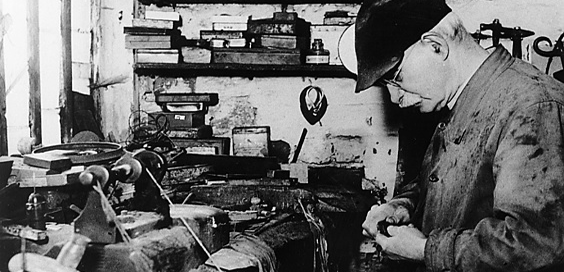
J is for Jet
Natalie IfillToday we're featuring the blackest of the black, a gemstone unlike many others, that also inspired the phrase "jet black". The clue is in the name... J is for Jet!

Jet has a very long and extensive history so get to it!


Jet grew in demand all over Europe and was particularly popular in Spain, where combs were carved from the stone and used to hold up women's veils in church. Between 1861 and the early 1870s, Jets popularity was at its all-time highest. Over 1000 people worked in the trade, in Whitby, a small seaside town in Yorkshire, England which was an abundant source. However, this number whittled down dramatically to 300 by 1884. By the end of World War II in 1945 supposedly only 3 survived with the industry dying out with them. In the 20th Century, up until current day, Jets popularity has started to grow again with vintage pieces being adored and well sought-after and new jewellers taking up the production of Jet jewellery once more.
Jet is made from wood that has changed under extreme pressure. Although it is very similar to coal, it forms slightly differently. When an individual piece of woody material, for example, a tree branch, ends up in a body of water and becomes waterlogged, it sinks to the bottom and becomes covered in organic-rich sediment. Over time, this material becomes compacted, degraded and heated in isolation. The forming Jet is thought to absorb oils released by the decay of organic debris such as plankton and algae. After this, the organic material has fully formed into Jet and in turn, become a type of sedimentary rock. Unlike coal, it doesn't have any fractures therefore it tends to be in uniform textures and a lot tougher. The origin of Jet was discovered when a study took place under magnification, Jet contains the preserved cellular structure found in the original woody plants, with some specimens of jet displaying these obvious structures without magnification. Both "hard" and "soft" Jet exists, the difference being whether they are formed in freshwater (soft) or saltwater (hard).
Where is Jet found?
The now-renowned Whitby Jet was created roughly 180 million years ago during the Jurassic era, from the wood of an Araucaria tree (now known as the Monkey Puzzle tree/Chilean Pine). During a violent weather event that caused flash flooding, large amounts of this tree were swept into the sea and the process of Jet being formed began. Whitby Jet supposedly has the best working quality, in turn producing the highest quality stones for jewellery production and is the largest source of Jet, therefore was (and still is) extremely popular to work with.
Five facts about Jet:
- The name "Jet" is derived from the Greek Lithos Gagates which translates as ‘Stone of Gagas’. Gagas was a town in Asia Minor (Turkey). This name passed into old French as Jaiet (modern French jais), and into English as Jet.
- "French Jet" is not Jet at all but rather a misleading nickname given to black glass frequently used to imitate Jet in the Victorian era.
- During the Victorian era where Jets popularity was at its highest, mining for the stone was both incredibly dangerous and paid poorly. Although the popularity of Jet Jewellery grew, the miner's wages remained the same at the very low price of approximately £1.25p per week for a six-day week.
- Jet is made up of carbon, just like Diamonds. However, where Diamonds are made up of 99.95% of carbon, Jet is only made up of 75%.
- If rubbed Jet can create a small electric charge, this is due to the triboelectric effect.
We'd love to hear your thoughts, what's your favourite thing about Jet or which gemstone would you like us to feature next! Comment below, like or share this post.
(Originally posted on Jan 2, 2022)














